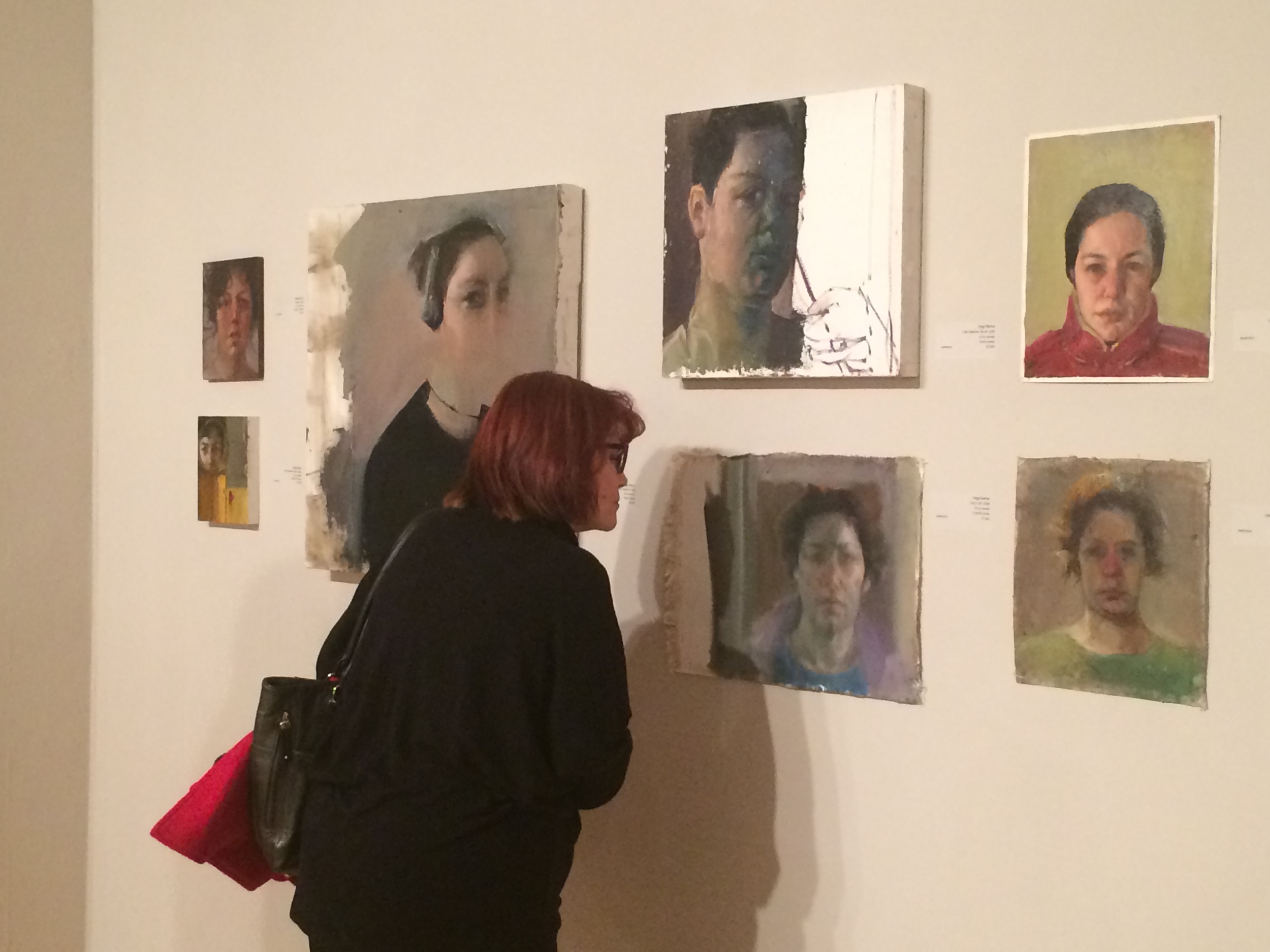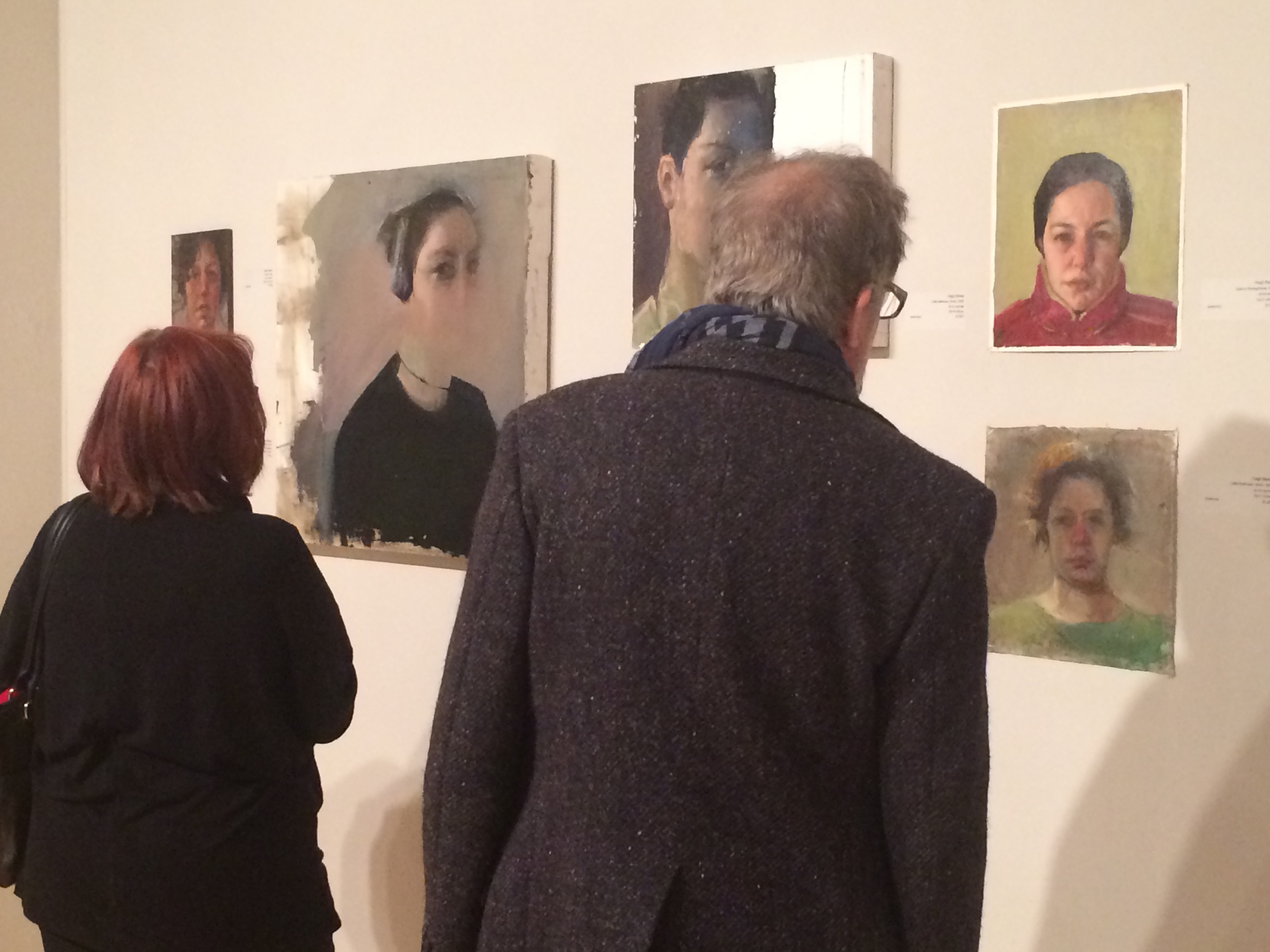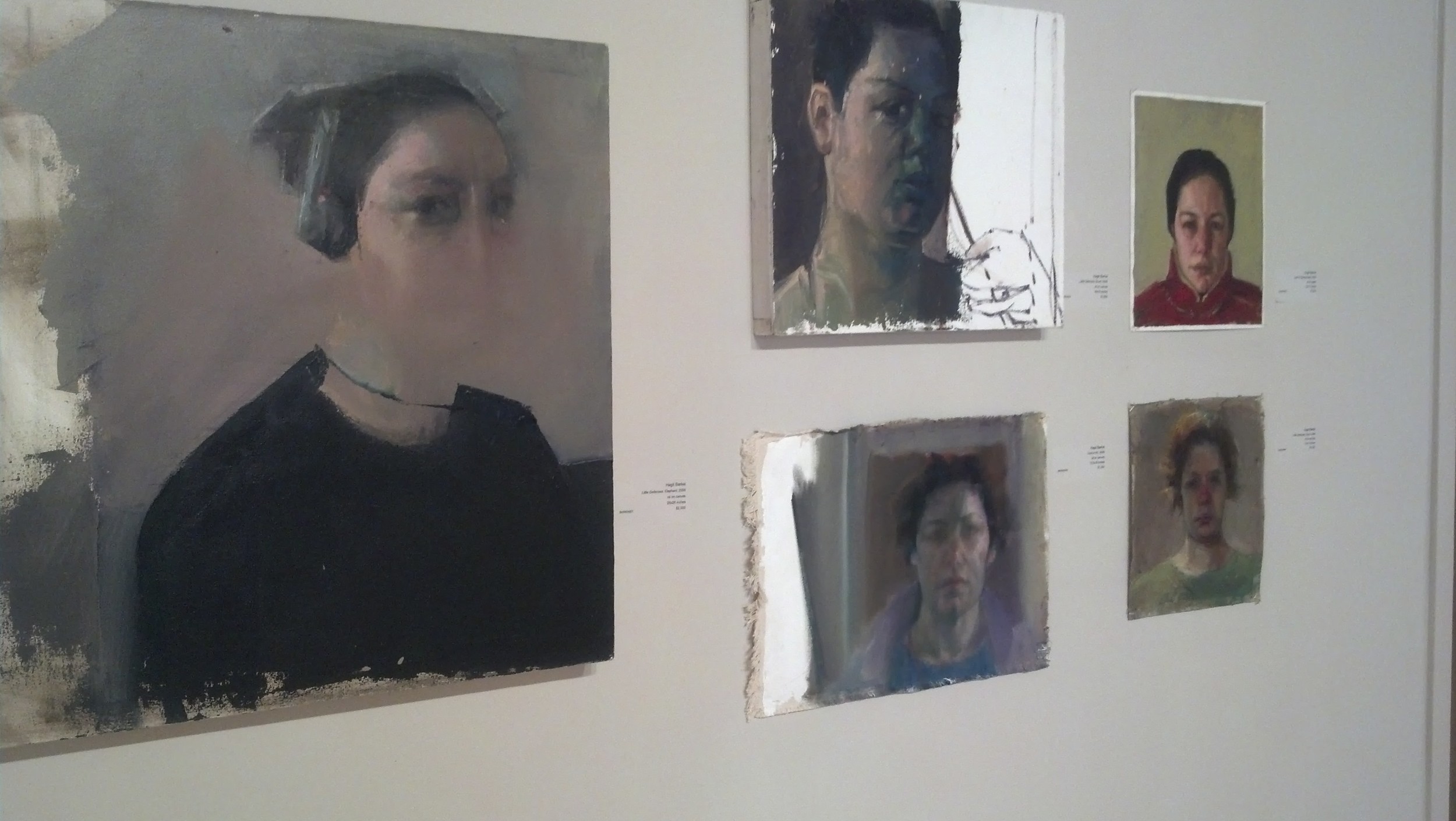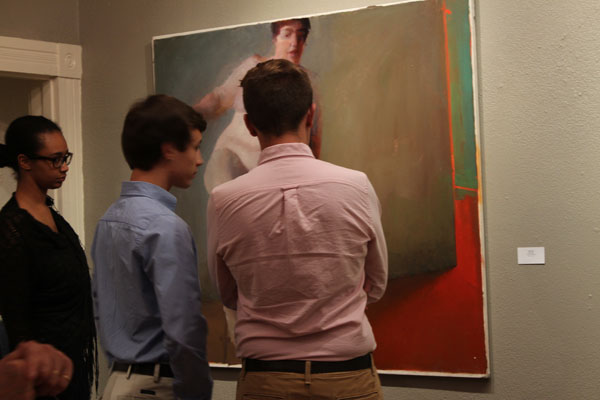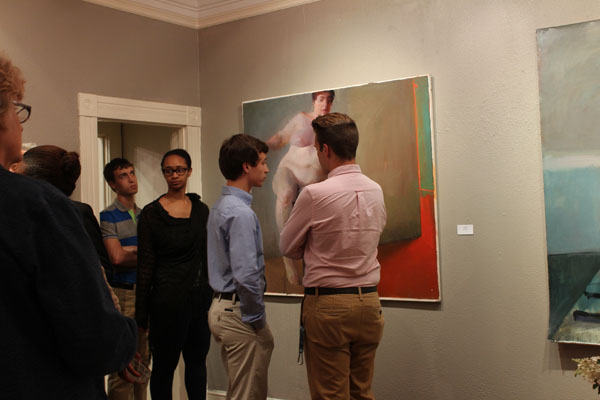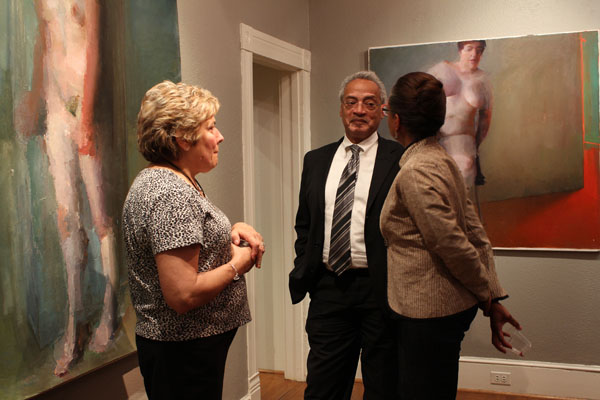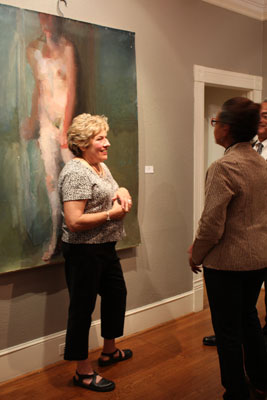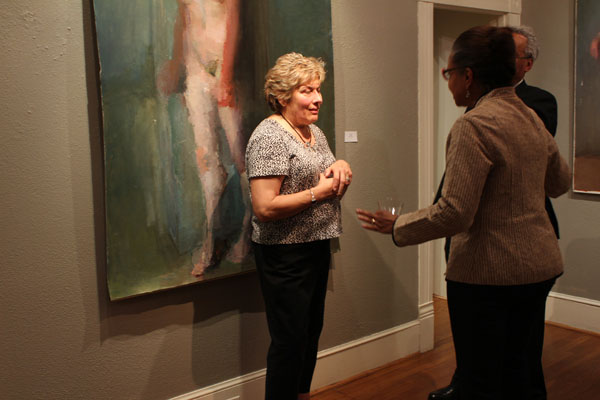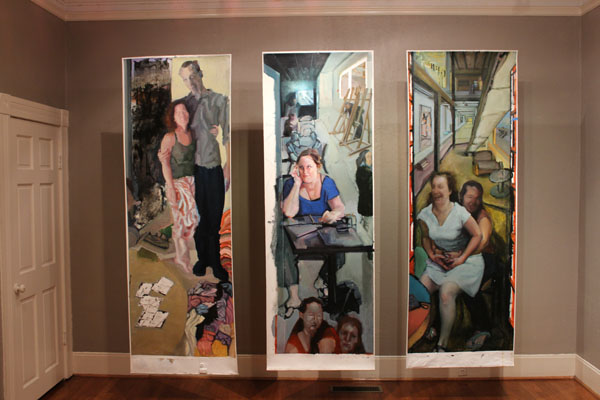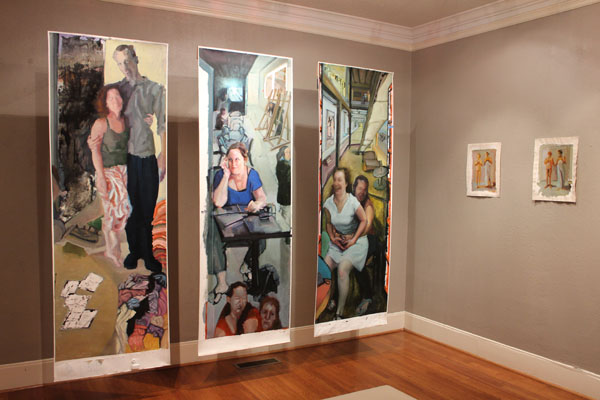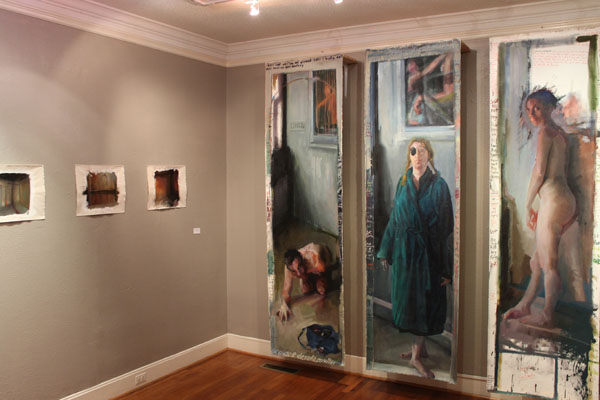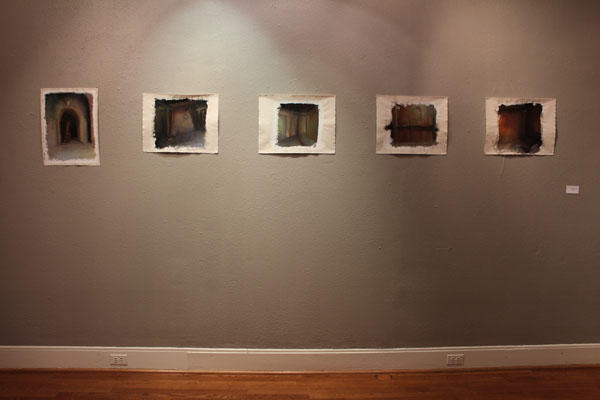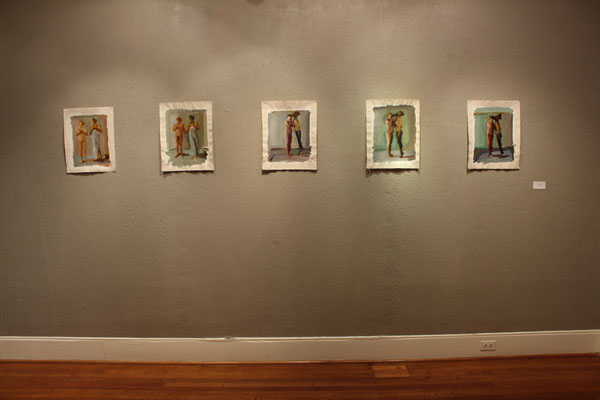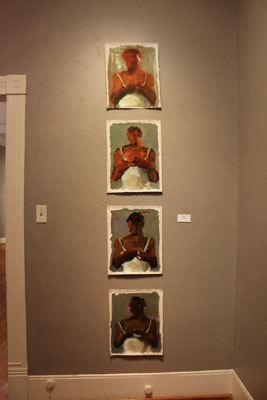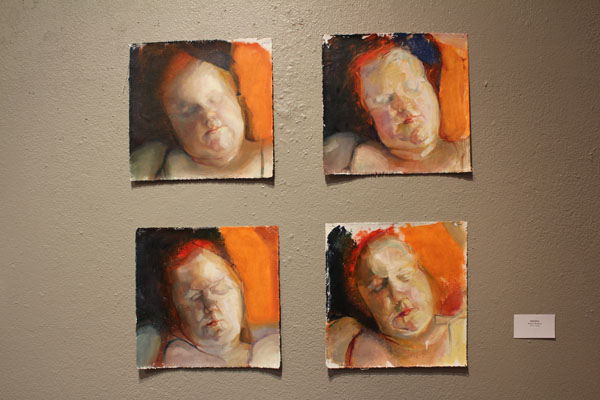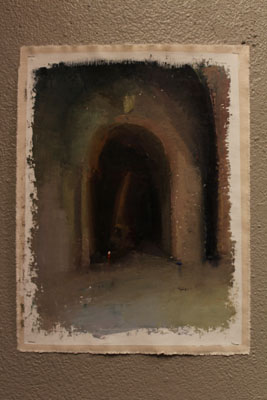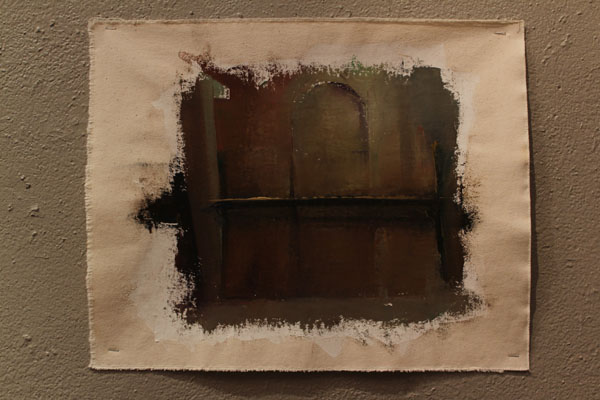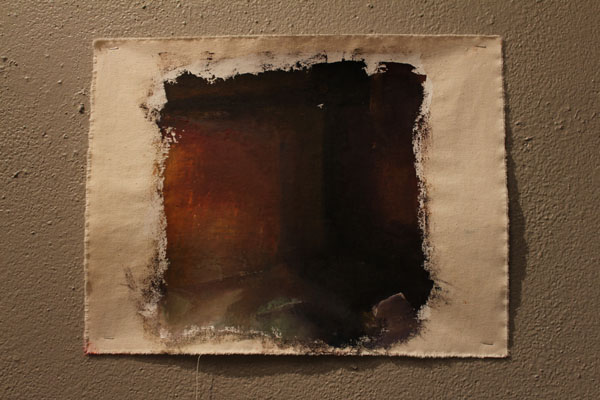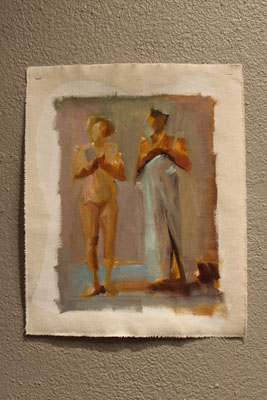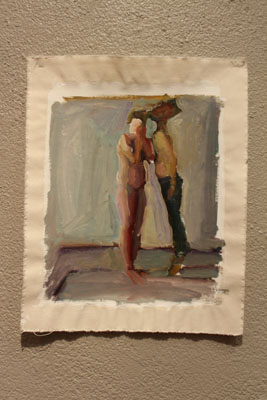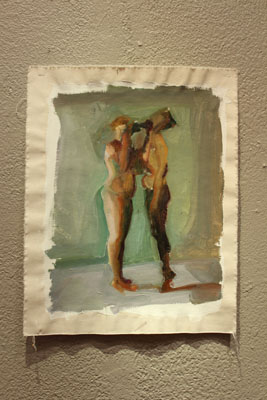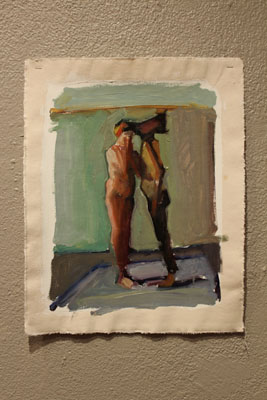When: Wednesday, March 1, 11:30- 12:45
Where: 1st room N1099, University of Houston Downtown
Department of Philosophy
College of Humanities and Social Sciences
One Main Street
Houston, TX 77002
Self Portraits Show at Greenhill, Greensboro NC
Buried Commentaries: Installation at Caldwell Arts Council.
The installation Buried Commentaries is a meditation on hiding. Hiding people. Hiding places. Hiding acts. Hiding what is happening in representations, in ceremonies, in ideologies, in an identity and morphing what happened into new stories, new images.
The installation includes six upright paintings with imagery from staged photo performances representing stories ranging from private to archetypical, and 30 smaller paintings of places in which hiding occurs through normalization, abandonment and memorials.
Among the places I visited are Camp Les Milles in south of France before, during and after its reconstruction into a memorial museum, museums and outdoor memorials in Jerusalem and Berlin, and checkpoints in the Israeli occupied West Bank in Palestinian territories, The photo performances were done with actors, dancers, performance artists, models, and friends in various locations including Houston Texas, Tel Aviv Israel, Berlin Germany and Brignole France.
Caldwell Arts Council
The Caldwell Arts Council is pleased to announce the August exhibit: “BODY WORKS” featuring figure artwork by Davidson College Assistant Art Professor Hagit Barkai in the main floor galleries. Figure artists featured in the upstairs gallery are: Bobbi Miller (Moran Wyoming), Dan Smith (Hickory NC), Jean Cauthen (Mint Hill NC), Kate Worm (Taylorsville NC), Kenny Walker (Lawndale NC), and Steve Brooks (Hickory NC).
Read MoreIt Looks Something Like This
It Looks Something Like This: opening night.
Read MoreIt Looks Something Like This
Solo Show at the Van Every Gallery, Davidson College
Opening Reception: November 3, 2011
"It Looks Something Like This" November 3rd
Solo Show at Van Every Gallery, Davidson NC
Resistance. Solo show. June 4th, Nau-haus Art
Resistance. Nau-haus Art. June 2011
Opening: June 4th, 6-9pm
303 & 223 E. 11th St. Houston Texas, 77008 Houston Texas
With text by Surpik Angelini and Dan Allison
Gallery contact: info@nau-haus.com
Resistance: Solo Show on June 4, 2011 at Nau-Haus Art
...
Read MoreThe Seven At Canal
Canal Street Gallery located at 2219 Canal St., Houston is proud to present seven local artists in a group
exhibition on August 6, 2010, 6-9pm.
A group exhibition featuring local Houston Artists working in different media: Painting, Printmaking and
Sculpture.
Please join us at the opening reception August 6. 6-9PM. 2219 Canal Street Houston, TX 77003
Artists include: Emily Sloan, Patrick Masterson, Armando Rodriguez, Merilee Minshew, Carlos
Hernandez, Hagit Barkai and Lenard Brown.
Integrazia אינטגרציה
Integrazia.Group show curated by Moti Golan. Tel Aviv-Ayelet Hashachar Gallery. Kibutz Ayelet
Hashachar, Israel. July 2010
התערוכה 'אינטגרציה' נפתחה בגלריית "תל-אביב/איילת השחר" בקיבוץ איילתהשחר. אוצר התערוכה הוא מוטי גולן. בראיון משנת 2005 הוא אומר: "במלחמה לקיתי בהלם קרב קשה, ומשהו בפציעה עשה לי סוויץ'. מאז התחלתי לצייר עוד ועוד יצירות בנושא מיתוס הגיבור והלם קרב, שהציגו כיצד אנו, החיילים, נראינו מתחת למדים. י
The Seven at Canal: Show on August 6, 2010
Canal Street Gallery located at 2219 Canal St., Houston is proud to present seven local artists in a group
Read MoreDirty Draw-ers
Drawing performance with models outside of Art League Houston. July 7 6-9
Read MoreSpaceTaker Announcement: Additional Support
HOUSTON (May 4, 2010) - This May, the Spacetaker's Artist Resource Center (ARC) will host "Additional Support," a group exhibition featuring paintings by Hagit Barkai, body casting sculptures by Kelley Devine and small metal sculptures by Jessica Jacobi.
Read Morela lengua muerta
Gulf Coast Art Corridor with labotanica present:
la lengua muerta
Opening reception: Friday, April 9, 2010, 6-8pm
Exhibition Dates: April 9 – May 15, 2010
labotanica is open to the public saturday, 1-5pm
labotanica presents La Lengua Muerta (The Dead Tongue) an exhibition of new works driven by private conversations about deciphering how Latin we still are. A group of uprooted and acclimating emerging artists are both subversively and romantically embracing classification as a point of departure to investigate their historical and current geography.
A panel of established artists, curators and critics: Elia Arce, Margarita Cabrera, Aisen Chacin, Delilah Montoya, Ruben Cordova and Surpik Angelini, will participate in dialogue at labotanica, offering the artists their Latin Label experience. At the core of these dialogues lays the need to move beyond traditional categories of “Latin American Art” and to frame new definitions, visual languages and creative practices among these artists in Houston.
La Lengua Muerta will yield visual and performance works to be as diverse (in form, subject, aesthetics, and influences) as being Latin American.
Participating artists include: Daniel Adame, Chuy Benitez, Aisen Caro Chacin, Claudia Cruz, Sebastian Forray, Jonathan Lopez, Angel Quesada, Cheyanne Ramos, Stephanie Saint Sanchez, and Alex Soares.
La Lengua Muerta is a Gulf Coast Art Corridor project curated by Aisen Caro Chacin
La Lengua Muerta is a Gulf Coast Art Corridor project conceived and commissioned by Elia Arce, and supported by an Arts and Activism Exchange grant. Arce is currently an Artist-In-Residence at DiverseWorks supported by a New Voices Fellowship, a Ford Foundation Initiative.
Texas National
Texas National 2010, curated by Judy Pfaff. Cole Arts Center, Nacogdoches TX, April 10.
Read MoreArt League Announcment: Conceal/Disclose: featuring the paintings of Hagit Barkai and the photographs of Tala Vahabzadeh
Presented by Art League Houston at Art League Houston
May 8-June 19, 2009
Art League Houston is pleased to announce ConcealDisclose, an exhibition of paintings by Hagit Barkai and photographs by Tala Vahabzadeh, which will be on view in the ALH project space May 8 through June 19, 2009. The opening reception for the exhibition is Friday, May 8, 2009 from 6:00 - 8:00 p.m., with an artist talk by Hagit Barkai at 6:15 p.m.
Both women come from the Middle East, and their works are filtered through the vantage point of personal experience. Although they work with different media, subjects, and approaches, both Vahabzadeh and Barkai deal with issues of concealment and disclosure, hence the title of the exhibition.
Hagit Barkai is from Israel. "Growing up in the ideological atmosphere in a Jewish Settlement Bet El in the West Bank, I was at the center of an increasingly hostile moral and political quarrel, which resulted in extremely defensive attitudes. Part of my education included a rewrite of events and ways of thinking that did not sustain the religious and national convictions while at the same time assuming to hold ideals such as liberalism, democracy and basic human rights. I see this work as creating a visual echo of public discourses that weave a camouflage around such events."
Her paintings focus on public and private demands addressed to the body. Viewing the body as the primary receptacle in which rights are given and removed, and through which histories take place and are understood, Barkai's subjects stand as metaphors for those social imperatives which direct and enforce aspects of identity and self. Through observations of body language, Barkai depicts the body for what it fails to be - how the body refuses to settle into any image or concept that confines and regulates, and how the body can never bridge the gap between its outward appearance and its inner realm of experience.
The series Every Body Knows is deeply informed by Barkai's personal history, and questions the borders, both literally and metaphorically drawn between victimization and victim-hood. Within Every Body Knows are four families of characters - the Blindfold, the Vomiters, the Middays and the Waiters, whose imagery stems from real events which form the basis of the political atmosphere in Israel, including unjustified detainments, public strip-searches, harassments, violence, and torture, all dependent upon a person's identity.
The portraits in Barkai's series Cross attempt to blur the line or "border" between young and old, alive and dead, normal and monstrous. In these, Barkai also demonstrates how the potential of a person, and the threats to that person's body are not so very different things. By creating images of newborns, along with, the dying, deformed or traumatized, the artist constructs a realm inhabited by those no longer fully existing, those not yet fully realized, and those that are for one reason or another considered not to be there at all.
Tala Vahabzadeh's current series of photographs are based on her personal experience of being an Iranian/Muslim woman undercover since she was nine years old. These works seek to show the conflicting worlds of tradition (public life) and modernity (personal life) and the effect this conflict has in the lives of contemporary women in Iran. Through simple, fairy tale like stories, Vahabzadeh uses the image of the veil in both its traditional iconic sense, and as a metaphor of the lack of freedom. Herself as subject, Vahabzadeh uses various props and arrangements, and different printing processes to create the appropriate ambience and atmosphere needed to expose the meaning behind her untitled pieces. In one work, the fully veiled Vahabzadeh perches high in the branches of a tree.
The image of a woman as a bird is based on a common joke in Iran that compares a woman wearing full veil to a black crow. In another photograph, the artist is hunched down, surrounded by greenery, as though in a garden. Again fully veiled, she munches on an apple, and on top of her head she wears a mask, which depicts the typical face of innocence in Persian Miniatures. As one might guess, this photo is a metaphor for Eve and the original sin. By not covering her face with the mask, Vahabzadeh asserts herself as a normal woman, who like any other woman is not that innocent, and is subject to on occasion doing "wrong" things.
Vahabzadeh says "These photographs are a representation of how I feel about being forced to cover myself and how in constantly being physically censored, I both consciously and unconsciously apply that censorship to my personal life."
ABOUT THE ARTISTS:
Hagit Barkai is from Israel and currently lives in Houston. She attended The Jerusalem Studio School and the Maryland Institute College of Art, and has a B.A. in Philosophy from Hebrew University of Jerusalem, and an M.F.A. from Penn State University, School of the Visual Arts. Her work has shown at venues that include the Susquehanna Art Museum and the State Museum in Harrisburg, PA, Penn State University in State College, PA, and Crane Arts in Philadelphia, among others. In the summer of 2009 she will be in an exhibition organized by MFANow entitled Identity, Self, which travels to New York, Los Angeles, and Beijing.
Among her awards are a 2008 CAA Professional Development Fellowship Award, 2007 First Place for the Visual Arts in University-Wide Research Exhibition, and a Penn State University Graduate Student Travel Grant to Israel.
Tala Vahabzadeh is from Tehran, Iran and currently lives in Houston, Texas. She received a Bachelors in Photography from the University of Tehran and is a Masters Candidate in Photography/Digital Media at the University of Houston. While living in Tehran she worked as a commercial photographer for an advertising and industrial photography company, and also assisted on a major documentary photography project that focused on the historical monuments of Iran. She has exhibited her work in both Houston and Tehran, at venues that include the University of Tehran, The University of Houston, Lawndale Art Center, Commerce Street Artists' Warehouse and Lone Star College, among others.
This project is funded in part by a grant from the City of Houston through Houston Arts Alliance. This project is funded in part by Texas Commission on the Arts. This project is also funded in part by the Houston Endowment, Inc., The Brown Foundation, and the Wortham Foundation.
ABOUT ART LEAGUE HOUSTON: Art League Houston is one of Houston's longest operating non-profit visual arts organizations and was the first alternative art space in Texas. Founded in 1948 and incorporated as a non-profit organization in 1953, Art League Houston (ALH) was created to promote the public appreciation of and interest in the visual arts. During the past 61 years, ALH has provided over 760 exhibitions to the Houston community, showcased the work of nearly 22,200 artists, and instructed over 35,000 students through the Art League School and Outreach Program. OUR MISSION The mission of Art League Houston is to cultivate awareness, appreciation, and accessibility of contemporary visual art within the community for its cultural enrichment. Art League Houston provides an opportunity for all members of the community to experience the contemporary visual arts. We achieve our mission through exhibitions, education and outreach programs.
Art League Houston acknowledges the following private foundations and corporations for their support this season: Laurie and Kevin Foxx and Aqua Foxx Productions, Houston Endowment, Inc., Brown Foundation, Inc., Eleanor and Frank Freed Foundation, John P. McGovern Foundation, Mrs. Katherine McGovern, JPMorgan Chase Foundation, Oshman Foundation, Target, and the Wortham Foundation, Inc. Art League Houston also wishes to thank its many generous individual donors for their support.
Conceal/Disclose: featuring the paintings of Hagit Barkai and the photographs of Tala Vahabzadeh
Presented by Art League Houston at Art League Houston
May 8-June 19, 2009
Art League Houston is pleased to announce ConcealDisclose, an exhibition of paintings by Hagit Barkai and photographs by Tala Vahabzadeh, which will be on view in the ALH project space May 8 through June 19, 2009. The opening reception for the exhibition is Friday, May 8, 2009 from 6:00 - 8:00 p.m., with an artist talk by Hagit Barkai at 6:15 p.m.
Both women come from the Middle East, and their works are filtered through the vantage point of personal experience. Although they work with different media, subjects, and approaches, both Vahabzadeh and Barkai deal with issues of concealment and disclosure, hence the title of the exhibition.
Hagit Barkai is from Israel. "Growing up in the ideological atmosphere in a Jewish Settlement Bet El in the West Bank, I was at the center of an increasingly hostile moral and political quarrel, which resulted in extremely defensive attitudes. Part of my education included a rewrite of events and ways of thinking that did not sustain the religious and national convictions while at the same time assuming to hold ideals such as liberalism, democracy and basic human rights. I see this work as creating a visual echo of public discourses that weave a camouflage around such events."
Her paintings focus on public and private demands addressed to the body. Viewing the body as the primary receptacle in which rights are given and removed, and through which histories take place and are understood, Barkai's subjects stand as metaphors for those social imperatives which direct and enforce aspects of identity and self. Through observations of body language, Barkai depicts the body for what it fails to be - how the body refuses to settle into any image or concept that confines and regulates, and how the body can never bridge the gap between its outward appearance and its inner realm of experience.
The series Every Body Knows is deeply informed by Barkai's personal history, and questions the borders, both literally and metaphorically drawn between victimization and victim-hood. Within Every Body Knows are four families of characters - the Blindfold, the Vomiters, the Middays and the Waiters, whose imagery stems from real events which form the basis of the political atmosphere in Israel, including unjustified detainments, public strip-searches, harassments, violence, and torture, all dependent upon a person's identity.
The portraits in Barkai's series Cross attempt to blur the line or "border" between young and old, alive and dead, normal and monstrous. In these, Barkai also demonstrates how the potential of a person, and the threats to that person's body are not so very different things. By creating images of newborns, along with, the dying, deformed or traumatized, the artist constructs a realm inhabited by those no longer fully existing, those not yet fully realized, and those that are for one reason or another considered not to be there at all.
Tala Vahabzadeh's current series of photographs are based on her personal experience of being an Iranian/Muslim woman undercover since she was nine years old. These works seek to show the conflicting worlds of tradition (public life) and modernity (personal life) and the effect this conflict has in the lives of contemporary women in Iran. Through simple, fairy tale like stories, Vahabzadeh uses the image of the veil in both its traditional iconic sense, and as a metaphor of the lack of freedom. Herself as subject, Vahabzadeh uses various props and arrangements, and different printing processes to create the appropriate ambience and atmosphere needed to expose the meaning behind her untitled pieces. In one work, the fully veiled Vahabzadeh perches high in the branches of a tree.
The image of a woman as a bird is based on a common joke in Iran that compares a woman wearing full veil to a black crow. In another photograph, the artist is hunched down, surrounded by greenery, as though in a garden. Again fully veiled, she munches on an apple, and on top of her head she wears a mask, which depicts the typical face of innocence in Persian Miniatures. As one might guess, this photo is a metaphor for Eve and the original sin. By not covering her face with the mask, Vahabzadeh asserts herself as a normal woman, who like any other woman is not that innocent, and is subject to on occasion doing "wrong" things.
Vahabzadeh says "These photographs are a representation of how I feel about being forced to cover myself and how in constantly being physically censored, I both consciously and unconsciously apply that censorship to my personal life."
ABOUT THE ARTISTS:
Hagit Barkai is from Israel and currently lives in Houston. She attended The Jerusalem Studio School and the Maryland Institute College of Art, and has a B.A. in Philosophy from Hebrew University of Jerusalem, and an M.F.A. from Penn State University, School of the Visual Arts. Her work has shown at venues that include the Susquehanna Art Museum and the State Museum in Harrisburg, PA, Penn State University in State College, PA, and Crane Arts in Philadelphia, among others. In the summer of 2009 she will be in an exhibition organized by MFANow entitled Identity, Self, which travels to New York, Los Angeles, and Beijing.
Among her awards are a 2008 CAA Professional Development Fellowship Award, 2007 First Place for the Visual Arts in University-Wide Research Exhibition, and a Penn State University Graduate Student Travel Grant to Israel.
Tala Vahabzadeh is from Tehran, Iran and currently lives in Houston, Texas. She received a Bachelors in Photography from the University of Tehran and is a Masters Candidate in Photography/Digital Media at the University of Houston. While living in Tehran she worked as a commercial photographer for an advertising and industrial photography company, and also assisted on a major documentary photography project that focused on the historical monuments of Iran. She has exhibited her work in both Houston and Tehran, at venues that include the University of Tehran, The University of Houston, Lawndale Art Center, Commerce Street Artists' Warehouse and Lone Star College, among others.
This project is funded in part by a grant from the City of Houston through Houston Arts Alliance. This project is funded in part by Texas Commission on the Arts. This project is also funded in part by the Houston Endowment, Inc., The Brown Foundation, and the Wortham Foundation.
ABOUT ART LEAGUE HOUSTON: Art League Houston is one of Houston's longest operating non-profit visual arts organizations and was the first alternative art space in Texas. Founded in 1948 and incorporated as a non-profit organization in 1953, Art League Houston (ALH) was created to promote the public appreciation of and interest in the visual arts. During the past 61 years, ALH has provided over 760 exhibitions to the Houston community, showcased the work of nearly 22,200 artists, and instructed over 35,000 students through the Art League School and Outreach Program. OUR MISSION The mission of Art League Houston is to cultivate awareness, appreciation, and accessibility of contemporary visual art within the community for its cultural enrichment. Art League Houston provides an opportunity for all members of the community to experience the contemporary visual arts. We achieve our mission through exhibitions, education and outreach programs.
Art League Houston acknowledges the following private foundations and corporations for their support this season: Laurie and Kevin Foxx and Aqua Foxx Productions, Houston Endowment, Inc., Brown Foundation, Inc., Eleanor and Frank Freed Foundation, John P. McGovern Foundation, Mrs. Katherine McGovern, JPMorgan Chase Foundation, Oshman Foundation, Target, and the Wortham Foundation, Inc. Art League Houston also wishes to thank its many generous individual donors for their support.
CAA NAMES 2007 FELLOWS
This past year, CAA awarded two grants and four honorable mentions through the Professional Development Fellowship Program.
CAA initiated the program in 1993 to help student artists and art historians bridge the gap between their graduate studies and professional careers. The program’s main purpose is to support outstanding students from socially and economically diverse backgrounds who have been underrepresented in their fields. By offering financial assistance to promising MFA and PhD students, CAA can assist the rising generation during this important transitional period in their lives.
Unlike previous years in which CAA fellowships were awarded in two parts—$5,000 to the fellows at the outset and $10,000 to an employer (with a matching requirement) upon the recipients securing a professional position—fellows are now honored with a one-time grant of $15,000 to help them with various aspects of their work, whether it be for their job-search expenses or purchasing materials for their studio. CAA believes a grant of this kind, without contingencies, can best nurture artists and scholars at the beginning of their professional careers.
Both fellows and honorable mentions receive free one-year CAA memberships and complimentary registration to CAA’s Annual Conference.
2007 Fellow in Visual Art
Hagit Barkai is an MFA student in visual arts at Pennsylvania State University in University Park, where she is currently working on her thesis show, Every Body Knows. An Israeli native, Barkai received a BA in philosophy from Hebrew University of Jerusalem and studied painting and drawing at the Jerusalem Studio School.
Viewing the body as the prime location in which rights are given and removed, and through which histories take place and are understood, Barkai reflects somatic experiences in her work, seeing them as political, social, and psychological symbols. The bodies in her paintings are confined within the frame in unstable and uncomfortable positions. Her work focuses on conflicts regarding identities, morality, and difference, which are embodied through demands addressed to the body in public and personal spaces. She is influenced by cultural critics such as Julia Kristeva, Luce Irigaray, and Judith Butler, and by artists such as Hannah Wilke, Mona Hatoum, and Marlene Dumas.
Barkai’s paintings have been exhibited at Chashama Gallery in New York and at the Pennsylvania State Museum in Harrisburg. Her painting represented Pennsylvania State University at the Big Ten Conference in Chicago, Illinois. At Penn State, she received a first-place award in the university-wide Graduate Research Exhibition; a travel grant to Israel from the University’s School of Visual Arts; and a painting commission from the Alumni Association.
CAA Names Fellows
This past year, CAA awarded two grants and four honorable mentions through the Professional Development Fellowship Program.
CAA initiated the program in 1993 to help student artists and art historians bridge the gap between their graduate studies and professional careers. The program’s main purpose is to support outstanding students from socially and economically diverse backgrounds who have been underrepresented in their fields. By offering financial assistance to promising MFA and PhD students, CAA can assist the rising generation during this important transitional period in their lives.
Unlike previous years in which CAA fellowships were awarded in two parts—$5,000 to the fellows at the outset and $10,000 to an employer (with a matching requirement) upon the recipients securing a professional position—fellows are now honored with a one-time grant of $15,000 to help them with various aspects of their work, whether it be for their job-search expenses or purchasing materials for their studio. CAA believes a grant of this kind, without contingencies, can best nurture artists and scholars at the beginning of their professional careers.
Both fellows and honorable mentions receive free one-year CAA memberships and complimentary registration to CAA’s Annual Conference.
2007 Fellow in Visual Art
Hagit Barkai is an MFA student in visual arts at Pennsylvania State University in University Park, where she is currently working on her thesis show, Every Body Knows. An Israeli native, Barkai received a BA in philosophy from Hebrew University of Jerusalem and studied painting and drawing at the Jerusalem Studio School.
Viewing the body as the prime location in which rights are given and removed, and through which histories take place and are understood, Barkai reflects somatic experiences in her work, seeing them as political, social, and psychological symbols. The bodies in her paintings are confined within the frame in unstable and uncomfortable positions. Her work focuses on conflicts regarding identities, morality, and difference, which are embodied through demands addressed to the body in public and personal spaces. She is influenced by cultural critics such as Julia Kristeva, Luce Irigaray, and Judith Butler, and by artists such as Hannah Wilke, Mona Hatoum, and Marlene Dumas.
Barkai’s paintings have been exhibited at Chashama Gallery in New York and at the Pennsylvania State Museum in Harrisburg. Her painting represented Pennsylvania State University at the Big Ten Conference in Chicago, Illinois. At Penn State, she received a first-place award in the university-wide Graduate Research Exhibition; a travel grant to Israel from the University’s School of Visual Arts; and a painting commission from the Alumni Association.
